FIG. 3
CAUTION: Never use the band saw to cut resin materials which are subject to melting.
Melting of resin material caused by high heat generated during cutting may cause the band
saw blade to become bound to the material, possibly resulting in overload and burn-out of the
motor.
Blade Speed
Your DW328 portable band saw is equipped with variable speed for greater versatility. Turn
the speed wheel (I) to select the desired speed (Fig. 1). Speed 1 is the slowest speed; Speed
6 is the fastest. Use speed settings 1–6 when connected to an AC power supply. When
connected to a DC power supply the setting MUST be Speed 6.
CAUTION: To avoid damage to the variable speed switch, always use Speed 6 (fastest)
when using a DC power source. Always turn the saw off, set the speed wheel (I) to Speed 6,
then turn the saw on.
When cutting copper, brass, bronze, aluminum, cast iron, angle iron, and mild steel, use a
higher speed.
When cutting plastic pipe, tougher steels, chrome steel, tungsten steel, stainless steel, and
other problem materials, use low speed.
NOTE: When cutting plastic pipe, higher speeds may melt plastic.
Removing and Installing Blades
WARNING: Turn off and unplug the tool before making any adjustments or
removing/installing attachments or accessories.
CAUTION: Cut Hazard. Blade tension lever is under spring pressure. Maintain control of
lever when releasing blade tension or blade may be released causing personal injury.
TO REMOVE BLADE (FIG. 1, 2)
1. Rotate the blade tension lever (H) clockwise until it stops to release tension in blade.
2. Turn the saw over and place it on a workbench or table with the cord to the left.
3. Begin removing the blade at the blade guard (M) and continue around the pulleys (L).
When removing the blade, tension may be released and the blade may spring free. SAW
BLADES ARE SHARP. USE CARE IN HANDLING THEM.
4. Inspect the guide rollers (F1, F2) and remove any large chips which may be lodged in
them. Lodged chips can prevent rotation of the guide rollers and cause flat spots on the
guide rollers.
5. Rubber tires (K) are mounted on the pulleys (L). The rubber tires should be inspected for
looseness or damage when changing the blade. Wipe any chips from the rubber tires on
the pulleys. This will extend tire life and keep the blade from slipping. If any looseness or
damage occurs, the tool should be brought to an authorized D
EWALT service center for
repair or replacement as soon as possible. Continued use of the tool with loose or
damaged rubber tires will cause unstable travel of the band saw blade.
TO INSTALL BLADE
1. Position the blade so that the teeth are on the bottom and angled toward the material
guide/work stop, as shown in Figures 1 and 3.
2. Slip the blade into the guide rollers (F), as shown in Figure 4.
3. Holding the blade in the guide rollers, place it around both pulleys (L) and through the
material guide/work stop (E), as shown in Figure 5.
4. Make sure that the blade is fully inserted into the guide rollers (F) and positioned square-
ly against the rubber tires (K).
5. Gently turn the saw over so that the pulleys rest on your work bench or table and rotate
the blade tension lever (H) counterclockwise until it stops. Make sure the teeth face away
from the bandsaw (Fig. 1, 3).
6. Turn the saw on and off a few times to ensure that the blade is seated properly.
Blade Tracking
WARNING: Turn off and unplug the tool before making any adjustments or
removing/installing attachments or accessories.
Your band saw is equipped with an adjustable blade tracking mechanism which assures
proper blade tracking at all times. The back edge of a properly aligned blade will run
lightly against one or both of the back up rollers in the blade guides. (The pressure between
the edge of the blade and the roller will be very slight and will not damage either the blade
or the roller.)
TO ADJUST THE BLADE TRACKING
1. Use a 9/16" (20mm) wrench to loosen the adjustment locking nut (G), shown in Figure 1
by turning it one or two turns counterclockwise.
2. Use a screwdriver to turn the tracking screw 1/4 turn. Turning the screw clockwise will
move the blade up toward the blade guide rollers. Turning the screw counterclockwise
will move the blade down away from the rollers.
3. Adjust so that the back edge of the blade lightly touches the rollers then securely tighten
the locking nut. (It will be necessary to plug the saw in and run it to observe the tracking.)
4. Observe blade tracking between runs and repeat Steps 1–4 as necessary to achieve
proper blade tracking.
BLADE DESCRIPTION
Type of band saw blade Bi-Metal
Number of teeth per inch 24 18 14 10 14/18 10/14
Workpiece thickness
1/8" and under • •
1/8"- 1/4" • •
1/4" - 13/32" • •
13/32" and over •
A
E
F1
J
I
BLADE
DIRECTION
DIRECTION DE
LA LAME
DIRECCIÓN
DE LA HOJA
L
E
FIG 4
Item Model DW328
Motor Type Protected type, series commutator motor
Power source single-phase, AC 60Hz
Voltage 120 volts
Full-load current 6 amp
Band Saw Dimensions 1/2" x 44-7/8" x .020"
(12.5 mm x 1140 mm x .5 mm)
Blade Peripheral speed 100 - 265 ft/min (30 -80 m/min)
Max. Cutting Pipe outer dimensions 4-3/4" (120 mm)
Dimensions Stock 4-1/2" x 4-3/4" (114 mm x 120 mm)
Net Weight 14 lbs. (6.4 kg)
Cord 3 conductor type captive cable 8.0 ft. (2.4 m)
FIG. 1
FIG. 2
FIG. 5
J
K
E
BLADE DIRECTION / DIRECTION DE LA LAME / DIRECCIÓN DE LA HOJA
YES / OUI / SÍ
NO / NON / NO
FIG. 7
RECOMMENDED CUTTING POSITIONS / POSITIONS DE COUPE
RECOMMANDÉES / POSICIONES DE CORTE RECOMENDADAS
FIG. 6
C
D
B
H
F2
M
L
POSITION OF TEETH ON LEFT SIDE OF MACHINE
POSITION DES DENTS DU CÔTÉ GAUCHE, SUR LE CÔTÉ DE LA MACHINE
POSICIÓN DE LOS DIENTES SOBRE LADO IZQUIERDO DEL COSTADO DE LA MÁQUINA
Article Modèle DW328
Moteur Type Type protégé, série moteur à collecteur
Circuit d’alimentation électrique monophasé, c.a., 60Hz
Tension 120 volts
Courant de pleine charge 6 A
Lame de scie Dimensions 12,5 mm x 1 140 mm x 0,5 mm
à ruban (1/2 po x 44-7/8 po x .020 po)
Vitesse périphérique 30 à 80 m/min (100 - 265 pi/min)
Dimensions Dimensions externes du tuyau 120 mm (4-3/4 po)
maximales Matériau à couper 114 mm x 120 mm
de la coupe (4-1/2 po x 4-3/4 po)
Poids net 6,4 kg (14 lb)
Cordon Fiche à 3 broches et à 3
conducteurs de 2,4 m (8,0 pi))
Artículo Modelo DW328
Motor Tipo Motor conmutador en serie, tipo protegido
Fuente de alimentación CA 60 Hz, monofásica
Voltaje 120 voltios
Corriente a plena carga 6 amperios
Hoja de la sierra Dimensiones 12,5 mm x 1 140 mm x 0,5 mm
de banda (1/2 pulg. x 44-7/8 pulg. x .020 pulg.)
Velocidad periférica 30 - 80 m/min (100 - 265 pies/min)
Dimensiones Dimensiones exteriores
máximas de de tubería 120 mm (4-3/4 pulg.)
corte Material a cortar 114 mm x 120 mm (4-1/2 x 4-3/4 pulg.)
Peso neto 6,4 kg (14 lb)
Cable Cable cautivo de 3 conductores, de 2,4 m
(8,0 pies) de largo
YES / OUI / SÍ
YES / OUI / SÍYES / OUI / SÍ
YES / OUI / SÍ
YES / OUI / SÍ
NO / NON / NO
NO / NON / NO
NO / NON / NO
NO / NON / NO
NO / NON / NO
G
L
L
F
J
E

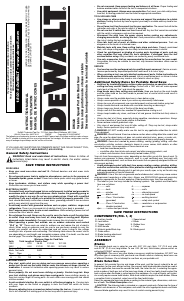


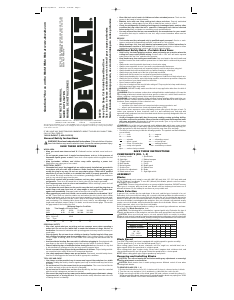
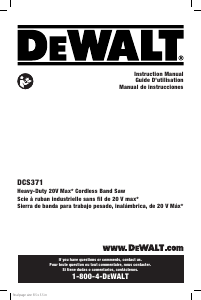
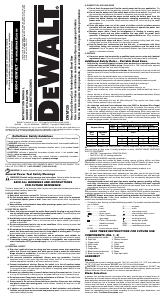
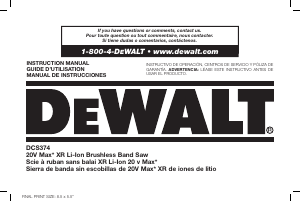
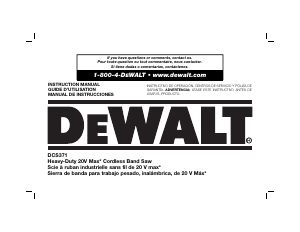
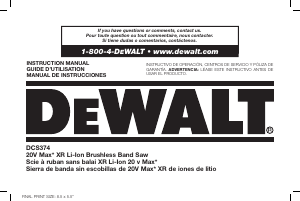
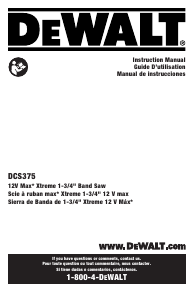
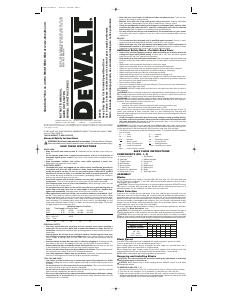
Join the conversation about this product
Here you can share what you think about the DeWalt DW328 Band Saw. If you have a question, first carefully read the manual. Requesting a manual can be done by using our contact form.